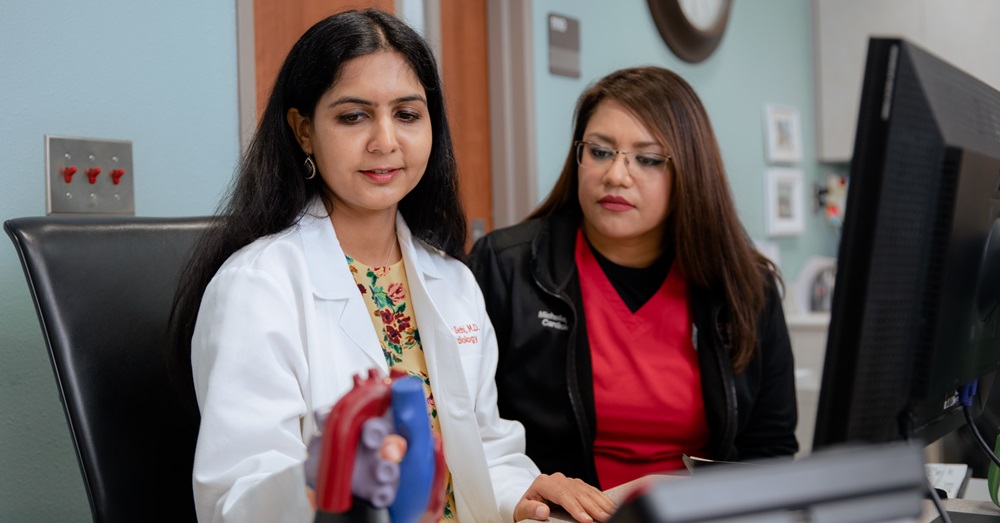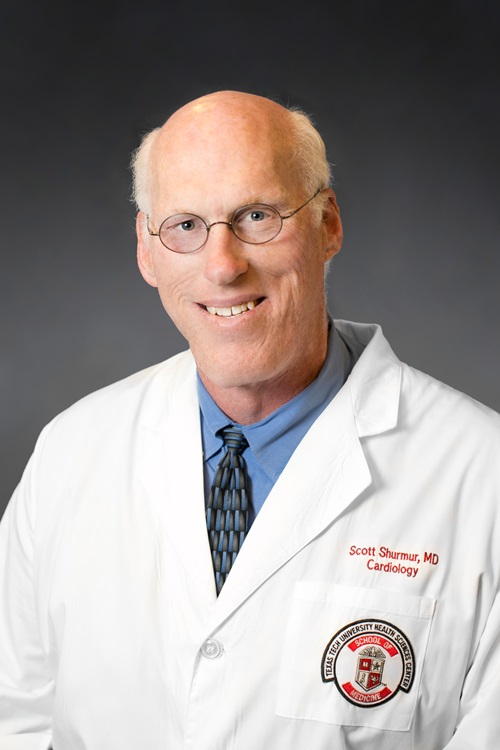Women’s Health Month: TTUHSC Experts Highlight Gender Disparities in Heart Health Awareness
A Survivor and Advocate Shares Her Tale of Life-Saving Persistence

Cardiovascular disease presents gender-specific differences and challenges.
Prim Naegele had just switched seats with her teenage daughter during a road trip when she first felt pain in her chest and on the left side of her neck. It was the beginning of a 19-day odyssey that ultimately changed and saved her life.
“I thought, you know, that's kind of weird, but kind of blew it off as just anxiety with a new driver and thinking that was it,” she recalled.
When the 45-year-old experienced the pain again the next day, she went to a nearby clinic. All her bloodwork and a battery of tests, including an EKG, came back normal.
“I have no family history of heart disease,” Naegele said. “I'm not a smoker. My cholesterol is great. My blood pressure is great. They recommended that I get a stress test in the next six months or so.”
One day, the pain returned and shot down her left arm. She drove straight to another nearby clinic and tested for all the things she was tested for before, plus more. Everything turned out normal.
“But thankfully, the doctor did not feel we should just let it go,” Naegele said. “He recommended that I get a stress test. That test indicated a slight abnormality.”
Naegele was referred to a cardiologist who ordered a CAT scan and was told she had 80% blockage of her left anterior descending artery (L-A-D). A widowmaker heart attack occurs when you have complete blockage of the L-A-D.
Naegele added, “My reaction was, ‘I'm a walking time bomb?’ And they said, ‘Absolutely, you are.’ Two days later, I had a stent placed.”
Naegele conceded that while her story is cautionary, it’s also an anomaly in some respects. She was relatively young; had no health, lifestyle or family history risks; recognized her symptoms even though they did not correspond to exertion; and sought medical care immediately and more than once.
She believes all her health care providers did the right thing given the circumstances. Still, her conviction that something was seriously wrong led her to keep seeking answers. “I think the thing that saved me was my inner voice telling me that there was something more and to keep pushing,” she said.
May is Women’s Health Month, and cardiovascular disease is one of many medical conditions that present gender-specific differences and challenges.

Scott Shurmur, M.D.
Scott Shurmur, M.D., a cardiologist with Texas Tech Physicians and chair of the Department of Internal Medicine at the Texas Tech University Health Sciences Center (TTUHSC), said education efforts by organizations like the American Heart Association and the TTUHSC’s Laura W. Bush Institute for Women’s Health are proving effective in raising awareness about how to prevent, recognize and treat cardiovascular conditions in women. He said heart disease among women is often still underestimated, however.
“Despite all of the press that breast cancer gets, for instance, heart disease is still the number one killer of women,” Shurmur said. “In as many as 25% of coronary events, heart attacks and sudden death can be the first symptom. And sudden death as the first symptom is more common in women than men.”
The Centers for Disease Control and Prevention data show the cardiac-related mortality rate for women in the U.S. has varied over the past decade.
“We're not particularly making progress. In the last five years, the incidence is not declining,” Shurmur said. “For a while, it was, and then smoking rates actually climbed a bit in women, which leveled off the decline. And now the increasing preponderance of type two diabetes and obesity has pushed the numbers a bit further, unfortunately.”
Several factors can prevent women with cardiovascular issues from getting timely diagnosis and treatment. Shurmur said women experience different and often less specific cardiovascular symptoms than men.
“It can just be some fatigue, some nausea, some shortness of breath. It doesn't have to be the classic crushing central chest pain that we see in TV and movies. That certainly does happen, but not exclusively.”
Shurmur noted that gender differences in symptoms can sometimes be an obstacle for women seeking cardiovascular care. “Certainly, be insistent. If one is worried about their cardiac health or potential cardiac concerns and their caregiver doesn't seem to be paying attention, then make some noise. Ask questions. Remind the practitioner, perhaps, that this is a gender equality issue. And heart disease does not discriminate between genders.”
TTUHSC Laura W. Bush Institute for Women’s Health Executive Director Connie Tyne said since its founding in 2007, supporting research in gender-specific health issues has been a key focus, along with education and advocacy.
“When it was getting started, all the research was basically aggregated and put into one big bowl, so everyone was treated the same,” she said. “As a result, while medications and devices may have been ideal for men, very often, 80% of side effects were in women. Women were not getting the personalized medicine they needed. So, there was a huge need for women's health research, particularly in the biological sex differences in medicine and disease.”
Shurmur said worldwide, research is starting to catch up with the gender gap in heart health. “We did a poor job of enrolling women in clinical trials for a long time,” he said. “In many studies that established hallmark therapies, women were only represented 25% or so. We're getting better at that. Still, rarely if ever crossing 50%, though, so we need to keep working in that field.”
Tyne said the Laura W. Bush Institute for Women’s Health tracks such trends. “We are strong advocates on every level,” she said. “We advocate to physicians to learn new things. We advocate for women to take that information to their doctor. We also advocate nationally in organizations that try to get the word out to everyone that biological sex differences are very real.”
Naegele wholeheartedly agreed. She is now assistant director of the TTUHSC’s Laura W. Bush Institute for Women’s Health in Lubbock and often speaks publicly about her heart health odyssey. She said both experiences have been life-changing.
“They're pretty much hand-in-hand. When I came on board with the institute, I had already had this situation with my heart disease.” Naegele said, “I had no idea how my story could be used to help so many women, but I shared it with a few people within our group. I have found the more I share my story, the more it's empowering both to me and to other women to realize that they can speak up and be an advocate for themselves.”
Related Stories
TTUHSC Dean to be Inducted into the National Academies of Practice as Distinguished Fellow
Gerard E. Carrino, Ph.D., MPH, dean of the TTUHSC Julia Jones Matthews School of Population and Public Health, will be inducted into the National Academies of Practice (NAP) as a Distinguished Fellow of the Public Health Academy.
TTUHSC School of Nursing Celebrates 10-Year Anniversary of the Abilene Community Health Center
The TTUHSC School of Nursing hosted a 10-Year Anniversary Celebration and Open House for the Abilene Community Health Center. The center is one of 71 Federally Qualified Health Centers (FQHCs) in Texas according to the Texas Health and Human Services.
TTUHSC Receives $1.3 Million HRSA Telehealth Resource Center Grant to Expand Telehealth in Texas and Louisiana
The TexLa Telehealth Resource Center, based at TTUHSC, has been awarded a $1.3 million, four-year grant from HRSA to strengthen and expand digital health services in Texas and Louisiana.
Recent Stories
TTUHSC Cancer Researcher Honored by National Academy of Inventors
C. Patrick Reynolds, M.D., Ph.D., director of the School of Medicine Pediatric Cancer Research Center at TTUHSC, has dedicated his life as a researcher to developing treatments for childhood cancers.
TTUHSC School of Nursing Celebrates 10 Years of the Veteran to BSN Program
The TTUHSC School of Nursing recognized the 10-year anniversary of the Veteran to Bachelor of Science in Nursing (VBSN) program during the fall 2025 commencement ceremonies held Dec. 13 in Lubbock, Texas.
TTUHSC Dean to be Inducted into the National Academies of Practice as Distinguished Fellow
Gerard E. Carrino, Ph.D., MPH, dean of the TTUHSC Julia Jones Matthews School of Population and Public Health, will be inducted into the National Academies of Practice (NAP) as a Distinguished Fellow of the Public Health Academy.
